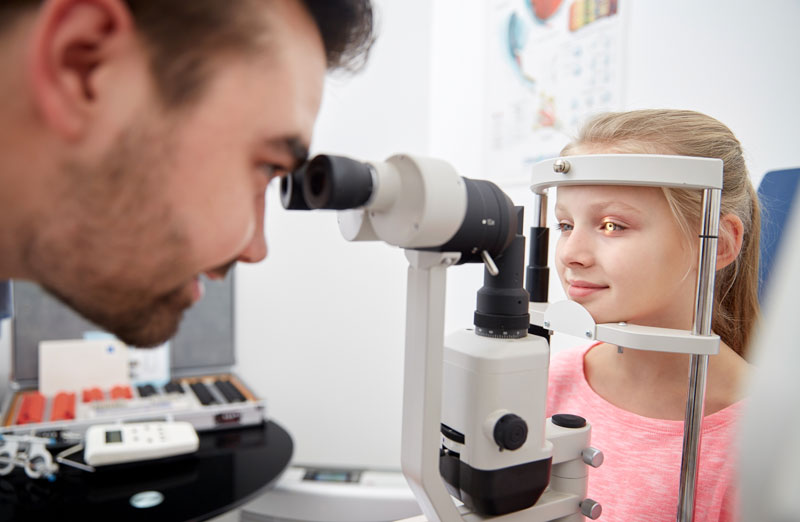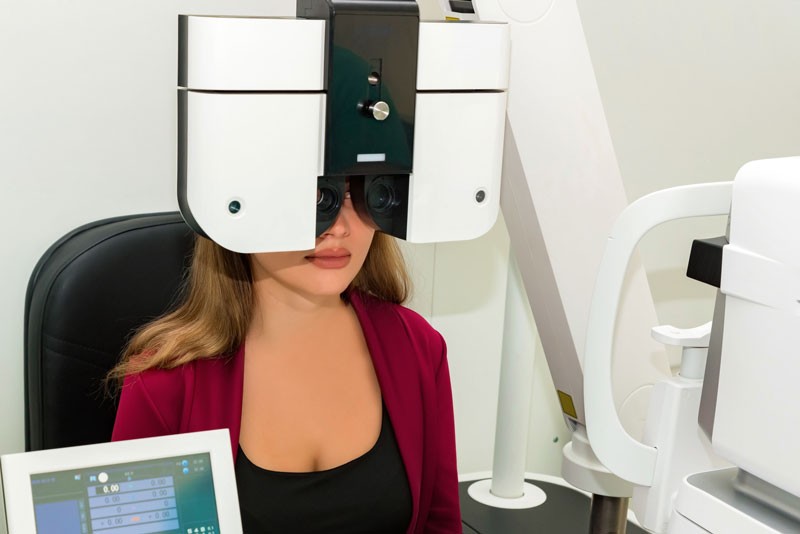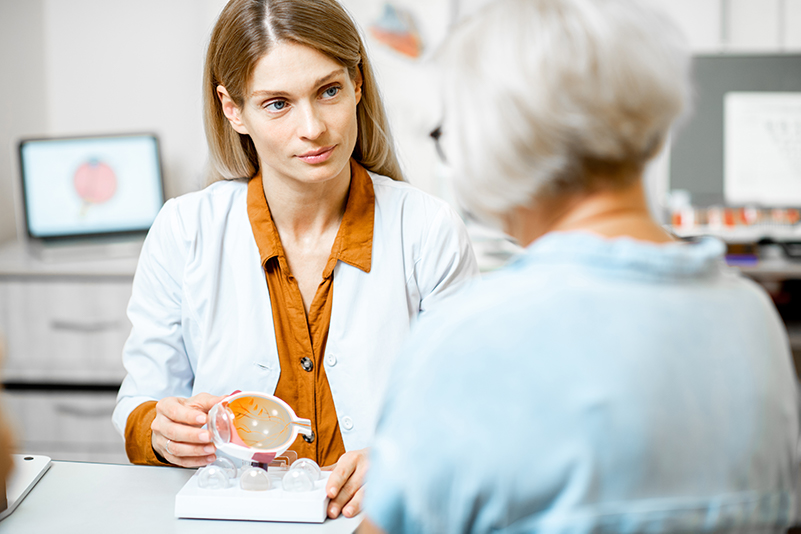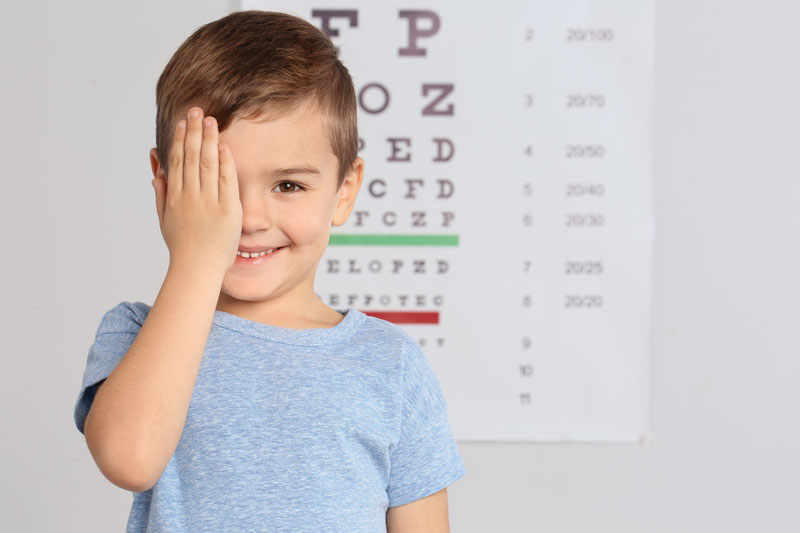Retinoscopy: The retinoscopy test helps your eye doctor get a good approximation of your eyeglasses prescription. For retinoscopy, the room lights are dimmed and an instrument containing wheels of lenses (called a phoropter) is positioned in front of your eyes. You are then asked to look at an object across the room (usually the big “E” on the wall chart or screen) while your doctor shines a light from a hand-held instrument into your eyes from arm’s length. Concurrently, your doctor flips different lenses on the phoropter in front of your eyes.
Based on the way the light reflects from your eye during this procedure, your doctor can get an idea of what is appropriate for your eyeglasses prescription. This test is especially useful for children and non-verbal patients who are unable to accurately answer the doctor's questions.
With the widespread use of automated instruments to help determine eyeglass prescriptions today, many doctors forgo performing retinoscopy during comprehensive eye exams. However, this test can provide valuable information about the clarity of the internal lens and other media inside the eye. So doctors who no longer perform this test routinely may still use it when examining someone who may be at risk of cataracts or other internal eye problems.
Refraction: The refraction test determines your exact eyeglasses prescription. During a refraction test, the doctor puts the phoropter in front of your eyes and shows you a series of lens choices. He or she then asks you which of the two lenses in each choice (“1 or 2,” “A or B,” for example) make the letters on the wall chart look clearer.
Based on your answers, your doctor determines your range of nearsightedness, farsightedness, and/or astigmatism, and concludes the type of eyeglass lenses required to correct the vision problem (which are called refractive errors).
Autorefractors and Aberrometers: Your eye doctor may use an autorefractor or aberrometer to help determine your glasses prescription. With both devices, a chin rest stabilizes your head while you look at a pinpoint of light or other image.
An autorefractor evaluates the way an image is focused on the retina, where vision processing takes place. This makes autorefractors especially useful when examining young children or people who may have difficulty with a regular (“subjective”) refraction, which requires the patient’s interaction. Automated refractions and subjective refractions are often used together during a comprehensive exam to determine the correct eyeglasses prescription.
An aberrometer uses advanced wavefront technology to detect even obscure vision errors based on the way light travels through your eye.
Cover test: While there are many ways for your eye doctor to check how your eyes work together, the cover test is the simplest and most common. During a cover test, the eye doctor has you focus on a small object at distance and then covers each of your eyes alternately while you stare at the target. The eye doctor observes how much each eye has to move when uncovered to pick up the fixation target.
The test is then repeated as you focus on a near object. Cover tests can detect even very subtle misalignments that can interfere with your eyes working together properly (binocular vision) and cause amblyopia or “lazy eye.”
Slit-lamp examination: The slit lamp (biomicroscope) is an instrument that the eye doctor uses to examine the health of your eyes. In order to thoroughly evaluate your eyes for signs of infection or disease, the slit lamp gives your doctor a highly magnified view of the structures of the eye, including the lens behind the pupil. The slit lamp is basically an illuminated binocular microscope that is mounted on a table and includes a chin rest and head band to position the patient’s head properly. With the help of hand-held lenses, your doctor can also use the slit lamp to examine the retina (the light-sensitive inner lining of the back of the eye.)
Tonometry (glaucoma testing): Tonometry is the name for a variety of tests that can be performed to determine the pressure inside the eye. Elevated internal eye pressure can cause glaucoma, or vision loss, due to damage to the sensitive optic nerve in the back of the eye. Since glaucoma is often the result of an increase of pressure inside the eye, these are important tests for ensuring the long-term health of your eyes.
The most common method used for tonometry is the “air puff” test – where an automated instrument discharges a small burst of air to the surface of your eye. Based on your eye's resistance to the puff of air, the machine calculates the pressure inside your eye – called your intraocular pressure (IOP). Though the test itself can be startling, nothing but air touches your eye during this measurement and there is no risk of eye injury from the air puff test.
Another popular way to measure eye pressure is with an instrument called an applanation tonometer, which is usually attached to a slit lamp. For this test, a yellow eye drop is placed on your eyes and creates a slightly heavy feeling when the drops start working. This is not a dilating drop — it is simply a numbing agent combined with a yellow dye. Then, as you stare straight ahead in the slit lamp, the doctor gently rests the bright-blue glowing probe of the tonometer on the front of each eye and manually measures the intraocular pressure. Like the air puff test, applanation tonometry is painless and takes just a few seconds.
Pupil dilation: Your comprehensive exam may include the use of dilating drops, which enlarge your pupils so your doctor can get a better view of the internal structures in the back of the eye. Dilating drops usually take about 20 minutes to start working. When your pupils are dilated, you become sensitive to light, because more light is being received by your eyes. You may also notice difficulty reading or focusing on close objects. These effects can last for up to several hours, depending on the strength of the drops used.
Dilation is very important for people with risk factors for eye disease, because it allows for a more thorough evaluation of the health of the inside of your eyes.



